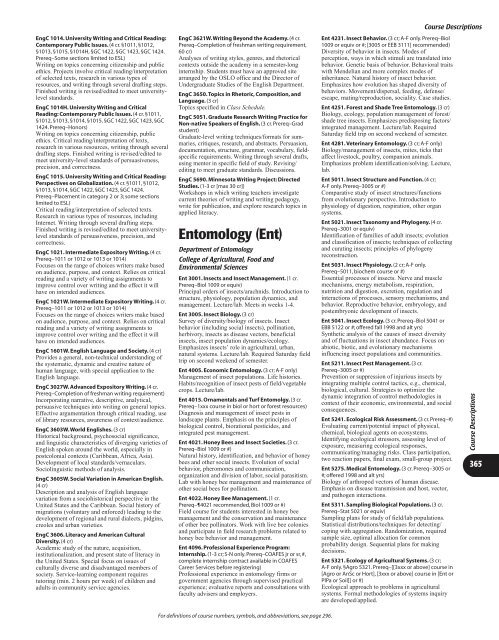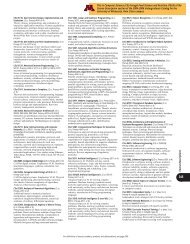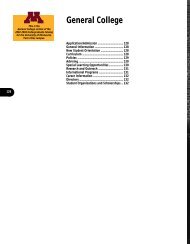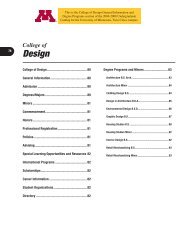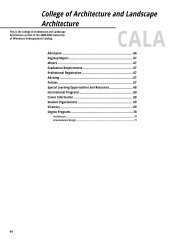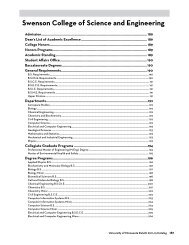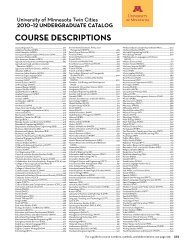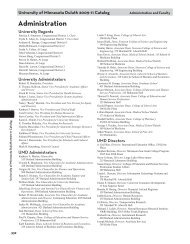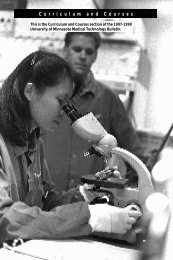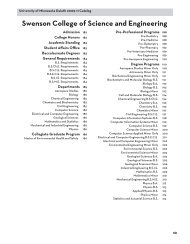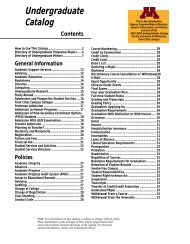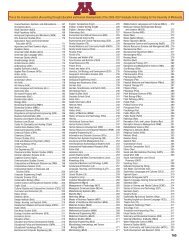CoursesâA through G and course numbers and symbols key
CoursesâA through G and course numbers and symbols key
CoursesâA through G and course numbers and symbols key
- No tags were found...
Create successful ePaper yourself
Turn your PDF publications into a flip-book with our unique Google optimized e-Paper software.
EngC 1014. University Writing <strong>and</strong> Critical Reading:Contemporary Public Issues. (4 cr. §1011, §1012,§1013, §1015, §1014H, §GC 1422, §GC 1423, §GC 1424.Prereq–Some sections limited to ESL)Writing on topics concerning citizenship <strong>and</strong> publicethics. Projects involve critical reading/interpretationof selected texts, research in various types ofresources, <strong>and</strong> writing <strong>through</strong> several drafting steps.Finished writing is revised/edited to meet universitylevelst<strong>and</strong>ards.EngC 1014H. University Writing <strong>and</strong> CriticalReading: Contemporary Public Issues. (4 cr. §1011,§1012, §1013, §1014, §1015, §GC 1422, §GC 1423, §GC1424. Prereq–Honors)Writing on topics concerning citizenship, publicethics. Critical reading/interpretation of texts,research in various resources, writing <strong>through</strong> severaldrafting steps. Finished writing is revised/edited tomeet university-level st<strong>and</strong>ards of persuasiveness,precision, <strong>and</strong> correctness.EngC 1015. University Writing <strong>and</strong> Critical Reading:Perspectives on Globalization. (4 cr. §1011, §1012,§1013, §1014, §GC 1422, §GC 1423, §GC 1424.Prereq–Placement in category 2 or 3; some sectionslimited to ESL)Critical reading/interpretation of selected texts.Research in various types of resources, includingInternet. Writing <strong>through</strong> several drafting steps.Finished writing is revised/edited to meet universitylevelst<strong>and</strong>ards of persuasiveness, precision, <strong>and</strong>correctness.EngC 1021. Intermediate Expository Writing. (4 cr.Prereq–1011 or 1012 or 1013 or 1014)Focuses on the range of choices writers make basedon audience, purpose, <strong>and</strong> context. Relies on criticalreading <strong>and</strong> a variety of writing assignments toimprove control over writing <strong>and</strong> the effect it willhave on intended audiences.EngC 1021W. Intermediate Expository Writing. (4 cr.Prereq–1011 or 1012 or 1013 or 1014)Focuses on the range of choices writers make basedon audience, purpose, <strong>and</strong> context. Relies on criticalreading <strong>and</strong> a variety of writing assignments toimprove control over writing <strong>and</strong> the effect it willhave on intended audiences.EngC 1601W. English Language <strong>and</strong> Society. (4 cr)Provides a general, non-technical underst<strong>and</strong>ing ofthe systematic, dynamic <strong>and</strong> creative nature ofhuman language, with special application to theEnglish language.EngC 3027W. Advanced Expository Writing. (4 cr.Prereq–Completion of freshman writing requirement)Incorporating narrative, descriptive, analytical,persuasive techniques into writing on general topics.Effective argumentation <strong>through</strong> critical reading, useof library resources, awareness of context/audience.EngC 3603W. World Englishes. (3 cr)Historical background, psychosocial significance,<strong>and</strong> linguistic characteristics of diverging varieties ofEnglish spoken around the world, especially inpostcolonial contexts (Caribbean, Africa, Asia).Development of local st<strong>and</strong>ards/vernaculars.Sociolinguistic methods of analysis.EngC 3605W. Social Variation in American English.(4 cr)Description <strong>and</strong> analysis of English languagevariation from a sociohistorical perspective in theUnited States <strong>and</strong> the Caribbean. Social history ofmigrations (voluntary <strong>and</strong> enforced) leading to thedevelopment of regional <strong>and</strong> rural dialects, pidgins,creoles <strong>and</strong> urban varieties.EngC 3606. Literacy <strong>and</strong> American CulturalDiversity. (4 cr)Academic study of the nature, acquisition,institutionalization, <strong>and</strong> present state of literacy inthe United States. Special focus on issues ofculturally diverse <strong>and</strong> disadvantaged members ofsociety. Service-learning component requirestutoring (min. 2 hours per week) of children <strong>and</strong>adults in community service agencies.EngC 3621W. Writing Beyond the Academy. (4 cr.Prereq–Completion of freshman writing requirement,60 cr)Analyses of writing styles, genres, <strong>and</strong> rhetoricalcontexts outside the academy in a semester-longinternship. Students must have an approved sitearranged by the OSLO office <strong>and</strong> the Director ofUndergraduate Studies of the English Department.EngC 3650. Topics in Rhetoric, Composition, <strong>and</strong>Language. (3 cr)Topics specified in Class Schedule.EngC 5051. Graduate Research Writing Practice forNon-native Speakers of English. (3 cr. Prereq–Gradstudent)Graduate-level writing techniques/formats for summaries,critiques, research, <strong>and</strong> abstracts. Persuasion,documentation, structure, grammar, vocabulary, fieldspecificrequirements. Writing <strong>through</strong> several drafts,using mentor in specific field of study. Revising/editing to meet graduate st<strong>and</strong>ards. Discussions.EngC 5690. Minnesota Writing Project: DirectedStudies. (1-3 cr [max 30 cr])Workshops in which writing teachers investigatecurrent theories of writing <strong>and</strong> writing pedagogy,write for publication, <strong>and</strong> explore research topics inapplied literacy.Entomology (Ent)Department of EntomologyCollege of Agricultural, Food <strong>and</strong>Environmental SciencesEnt 3001. Insects <strong>and</strong> Insect Management. (1 cr.Prereq–Biol 1009 or equiv)Principal orders of insects/arachnids. Introduction tostructure, physiology, population dynamics, <strong>and</strong>management. Lecture/lab. Meets in weeks 1-4.Ent 3005. Insect Biology. (3 cr)Survey of diversity/biology of insects. Insectbehavior (including social insects), pollination,herbivory, insects as disease vectors, beneficialinsects, insect population dynamics/ecology.Emphasizes insects’ role in agricultural, urban,natural systems. Lecture/lab. Required Saturday fieldtrip on second weekend of semester.Ent 4005. Economic Entomology. (3 cr; A-F only)Management of insect populations. Life histories.Habits/recognition of insect pests of field/vegetablecrops. Lecture/lab.Ent 4015. Ornamentals <strong>and</strong> Turf Entomolgy. (3 cr.Prereq–1xxx <strong>course</strong> in biol or hort or forest resources)Diagnosis <strong>and</strong> management of insect pests inl<strong>and</strong>scape plants. Emphasis on the principles ofbiological control, biorational pesticides, <strong>and</strong>integrated pest management.Ent 4021. Honey Bees <strong>and</strong> Insect Societies. (3 cr.Prereq–Biol 1009 or #)Natural history, identification, <strong>and</strong> behavior of honeybees <strong>and</strong> other social insects. Evolution of socialbehavior, pheromones <strong>and</strong> communication,organization <strong>and</strong> division of labor, social parasitism.Lab with honey bee management <strong>and</strong> maintenance ofother social bees for pollination.Ent 4022. Honey Bee Management. (1 cr.Prereq–4021 recommended, Biol 1009 or #)Field <strong>course</strong> for students interested in honey beemanagement <strong>and</strong> the conservation <strong>and</strong> maintenanceof other bee pollinators. Work with live bee colonies<strong>and</strong> participate in field research problems related tohoney bee behavior <strong>and</strong> management.Ent 4096. Professional Experience Program:Internship. (1-3 cr; S-N only. Prereq–COAFES jr or sr, #,complete internship contract available in COAFESCareer Services before registering)Professional experience in entomology firms orgovernment agencies <strong>through</strong> supervised practicalexperience; evaluative reports <strong>and</strong> consultations withfaculty advisers <strong>and</strong> employers.Course DescriptionsEnt 4231. Insect Behavior. (3 cr; A-F only. Prereq–Biol1009 or equiv or #; [3005 or EEB 3111] recommended)Diversity of behavior in insects. Modes ofperception, ways in which stimuli are translated intobehavior. Genetic basis of behavior. Behavioral traitswith Mendelian <strong>and</strong> more complex modes ofinheritance. Natural history of insect behavior.Emphasizes how evolution has shaped diversity ofbehaviors. Movement/dispersal, feeding, defense/escape, mating/reproduction, sociality. Case studies.Ent 4251. Forest <strong>and</strong> Shade Tree Entomology. (3 cr)Biology, ecology, population management of forest/shade tree insects. Emphasizes predisposing factors/integrated management. Lecture/lab. RequiredSaturday field trip on second weekend of semester.Ent 4281. Veterinary Entomology. (3 cr; A-F only)Biology/management of insects, mites, ticks thataffect livestock, poultry, companion animals.Emphasizes problem identification/solving. Lecture,lab.Ent 5011. Insect Structure <strong>and</strong> Function. (4 cr;A-F only. Prereq–3005 or #)Comparative study of insect structures/functionsfrom evolutionary perspective. Introduction tophysiology of digestion, respiration, other organsystems.Ent 5021. Insect Taxonomy <strong>and</strong> Phylogeny. (4 cr.Prereq–3001 or equiv)Identification of families of adult insects; evolution<strong>and</strong> classification of insects; techniques of collecting<strong>and</strong> curating insects; principles of phylogenyreconstruction.Ent 5031. Insect Physiology. (2 cr; A-F only.Prereq–5011, biochem <strong>course</strong> or #)Essential processes of insects. Nerve <strong>and</strong> musclemechanisms, energy metabolism, respiration,nutrition <strong>and</strong> digestion, excretion, regulation <strong>and</strong>interactions of processes, sensory mechanisms, <strong>and</strong>behavior. Reproductive behavior, embryology, <strong>and</strong>postembryonic development of insects.Ent 5041. Insect Ecology. (3 cr. Prereq–Biol 5041 orEBB 5122 or #; offered fall 1998 <strong>and</strong> alt yrs)Synthetic analysis of the causes of insect diversity<strong>and</strong> of fluctuations in insect abundance. Focus onabiotic, biotic, <strong>and</strong> evolutionary mechanismsinfluencing insect populations <strong>and</strong> communities.Ent 5211. Insect Pest Management. (3 cr.Prereq–3005 or #)Prevention or suppression of injurious insects byintegrating multiple control tactics, e.g., chemical,biological, cultural. Strategies to optimize thedynamic integration of control methodologies incontext of their economic, environmental, <strong>and</strong> socialconsequences.Ent 5241. Ecological Risk Assessment. (3 cr. Prereq–#)Evaluating current/potential impact of physical,chemical, biological agents on ecosystems.Identifying ecological stressors, assessing level ofexposure, measuring ecological responses,communicating/managing risks. Class participation,two reaction papers, final exam, small-group project.Ent 5275. Medical Entomology. (3 cr. Prereq–3005 or#; offered 1998 <strong>and</strong> alt yrs)Biology of arthropod vectors of human disease.Emphasis on disease transmission <strong>and</strong> host, vector,<strong>and</strong> pathogen interactions.Ent 5311. Sampling Biological Populations. (3 cr.Prereq–Stat 5021 or equiv)Sampling plans for study of field/lab populations.Statistical distributions/techniques for detecting/coping with aggregation. R<strong>and</strong>omization, requiredsample size, optimal allocation for commonprobability design. Sequential plans for makingdecisions.Ent 5321. Ecology of Agricultural Systems. (3 cr;A-F only. §Agro 5321. Prereq–[[3xxx or above] <strong>course</strong> in[Agro or AnSc or Hort], [3xxx or above] <strong>course</strong> in [Ent orPlPa or Soil]] or #)Ecological approach to problems in agriculturalsystems. Formal methodologies of systems inquiryare developed/applied.Course Descriptions365For definitions of <strong>course</strong> <strong>numbers</strong>, <strong>symbols</strong>, <strong>and</strong> abbreviations, see page 296.


